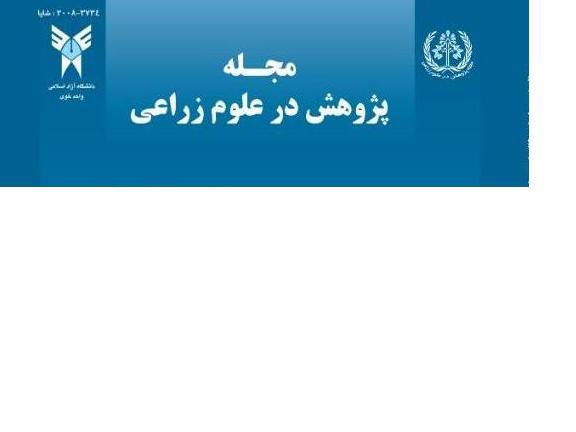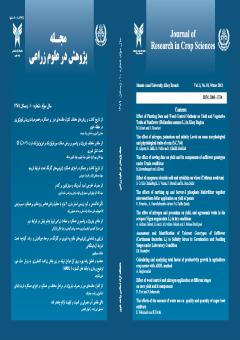اثر تاريخ كاشت بر عملكرد و اجزاي عملكرد ژنوتيپ¬هاي گلرنگ تحت شرايط اروميه
محورهای موضوعی : توليد محصولات زراعي
1 - مرکز تحقیقات کشاورزی ارومیه
کلید واژه: تاريخ كاشت, ژنوتيپ, عملكرد دانه, گلرنگ,
چکیده مقاله :
به منظور بررسي اثرات تاريخ كاشت بر ژنوتيپ¬هاي گلرنگ تحت شرايط اروميه، آزمايشي در سال زراعي 9-1388 انجام شد. آزمايش به صورت فاكتوريل در قالب طرح بلوكهاي كامل تصادفي با چهار تكرار اجرا شد. فاكتورهاي آزمايشي شامل تاريخ كاشت در چهار سطح (1 ارديبهشت، 15 ارديبهشت، 31 ارديبهشت و 15 خرداد) به عنوان فاكتور اول و پنج ژنوتيپ به نام¬¬هاي (IL-111،S-541، PI-250536، PI-250537 و (Syprus bregun به عنوان فاكتور دوم مورد بررسي قرار گرفتند. نتايج تجزيه واريانس نشان داد كه تأثير تاريخ كاشت بر عملكرد دانه، تعداد دانه در غوزه، تعداد غوزه در بوته، شاخص برداشت و درصد روغن معني¬دار بود. عملكرد دانه در تاريخ¬هاي كشت اول، دوم، سوم و چهارم به ترتيب 22/223، 65/197، 71/185، 99/173 گرم در متر مربع بود. بيشترين تعداد غوزه بارور، تعداد دانه در غوزه و وزن هزار دانه به ترتيب به ژنوتيپ¬هاي PI-250537، S-541 وSyprus bregun در اولين تاريخ كاشت اختصاص داشت. اثر متقابل تاريخ كاشت در ژنوتيپ براي صفات، تعداد شاخه جانبي، ماده خشك كل، عملكرد دانه، تعداد غوزه در بوته، تعداد دانه درغوزه، شاخص برداشت، درصد روغن و وزن هزار دانه معني¬دار بود (01/0 (P. ضرايب همبستگي بين صفات نشان داد، عملكرد دانه با صفت تعداد دانه در غوزه همبستگي مثبت و معني¬داري داشت. بر اساس این نتايج، كشت بهاره در اولين فرصت بهتر از كشت¬هاي تأخيري خواهد بود.
To investigate the effects of planting date of safflower genotypes under Urmia climatic conditions, an experiment was conducted in 2009-10. A factorial experiment was arranged in Randomized Complete Blocks Design with four replications. Four sowing date (April 21, May 5, May 21, June 5) and five genotypes (IL-111, S-541, PI-250536, PI-250537, Syprus bregun) were established levels as second factors. Results of analyses of variance showed that the effect of planting date were significantly differenct for traits of grain yield, number of grain per boll, number of bolls per plant, harvest index and oil grain percentage. The grain yield of first, second, third and fourth sowing dates were 223.12, 197.65, 185.71 and 173.99 gr/m2, respectively. The highest fertile boll, kernel per boll and 1000-kernel weight were allocated for PI-250537, S-541 and Syprus bregun genotypes in the first planting date, respectively. Interaction between planting date and genotype on lateral branch, total dry matter, grain yield, number of bolls per plant, number of grain per boll, harvest index, oil percentage and 1000-kernel weight were meaningful (P 0.01). Correlation coefficients between traits showed that there were positive significant differences for number of grain per boll with grain yield. Based on these results, early spring planting date will be move suitable than other dilatory planting.
Able, G. H. 1976. Relationship and uses of yield components in safflower breeding for high yield. Agronomy Journal. 68: 442- 447.
Able, G. H., and M. F. Driscoll. 1976. Sequential trait development and breeding for high yield in safflower. Crop Science. 16: 213 -216.
Ahmadi, M. R., and A. H. Omidi. 1996. Evaluation of harvesting time on oil yield of spring and autumn safflower varieties. Journal of Agricultural Science and Natural Resources. 27(4): 26-29. (In Persian).
Alessi, J., Power, J. F., and D. C. Zimmerman. 1981. Effects of seeding date and population on water use efficiency and safflower yield. Agronomy Journal. 73: 783-787.
Alessi, J., Power, J. F., and D. C. Zimmerman. 1994. Effect of seeding date and population on water use efficiency and safflower yield. Agronomy Journal. 73: 783-787.
Alinaghizadeh, M., M. Movahhedi Dehnavi, H. Faraji, A. Dehdari, and A. Gandomani. 2007. Effect of sowing dates on yield and yield components of different spring safflower (Carthamus tinctorius L.) cultivars as a double crop in Yasouj, Iran. International Safflower Conference, Australia.
Arsalan, B., Yildirim, B., Ilbas, A. I., Dede, O., and N. Okut. 1997. The effect of sowing date on yield and yield characters of varieties of safflower (Carthamus tincturius L.). pp. 125-131. 4th International Safflower Conference. Bari, Italy. June 2-7.
Bageri, M. 1995. The effects of planting date on yield and its components of safflower. M.Sc. Thesis University of Isfahan. 61pp. (In Persian).
Cazzato, E., Ventricelli, P., and A. Corleto. 1997. Effect of date of seeding and supplemental irrigation on hybrid and open pollinated safflower production in southern Italy. pp. 119-124. 4th International Safflower Conference. Bari, Italy. June 2-7.
Cholaky, L., Fernandez, E. M., Asnal, W. E., Giayetto, O., and Y. J. O. Plevich. 1993. Safflower (Cathamus tinctorius L.) sowing dates in Rio Cuouto. pp. 395-402. The 3th International Safflower conference. Beijing, China, June 14-18.
Coshge, B., and D. Kaya. 2008. Performance of some safflower varieties sown late autumn and late spring. University of Suleyman Demirel, Technology Institute, 43: 13-18.
Dadashi, N., and M. R. Khajepor. 2003. The effect of temperature and day length on development of safflower genotypes under field conditions. Journal of Agricultural Science and Natural Resources. 7(4): 83-102. (In Persian).
Dajue, L. 1989. Study of germ-plasm collection of safflower (Carthamus tinctorius L.) screening for long days. Sesame and Safflower Newslatter. 4: 213-218.
Dajue, L., and H. H. Mundel. 1996. Safflower (Carthamus tincturius L.) promoting the conservation and use of under utilized and neglected crops. Institute of Plant Genetics and Crop Plant Research, Gastersleben, International Plant Genetic Resource Institute, Rome, Italy. 83 p.
Falconer, D. S. 1989. Introduction to quantitative genetics. The Ronald Press Company. New York.
Gonzalez, J. L., Schneiter, A. A., Riveland, N. R., and B. L. Johnson. 1994. Response of hybrid and open pollinated safflower to plant population. Agronomy Journal. 86: 1070-1073.
Hashim, R. M., and A. A. Schinter. 1988. Semi-dwarf and conventional height sunflower performance at five plant population. Agronomy Journal. 80: 821-829.
Hirmath, S. M., B. M., Chitttapour, and M. M. Hasmahi. 1992. Inter-cropping of wheat (Triticum aestivum L.) and safflower (Carthamus tinctorius L.) at different spatial arrangements. Indian Journal Agronomy. 37: 338-340.
Jajarmi, V., M. Azizi, A. Shadlu, and A. H. Omidy-Tabrizi. 2005. The effect of density variety and planting date on yield and yield components of safflower. 7th International Safflower Conference. Australia. Juan 18-19.
Mohammady-Nikpor, A. R., and V. A. Kocheki. 1999. The effect of planting date on yield and its components of safflower growth indicators. Journal of Agricultural Science and Technology. 13(1): 7-15. (In Persian).
Naraki, F. 1998. Safflower planting. Publications of Agriculture Research Center of Kohgiluyeh Boyer Ahmad Province. 109pp. (In Persian).
Naseri, F. 1996. Oil seeds. Razavi Publications. 823 pp. (In Persian).
Nejadshamlu, A. R. 1996. Evaluation of morphological and physiological traits of spring safflower. M. Sc. Thesis, University of Agriculture Islamic Azad Khorasegan, Isfahan. 89pp. (In Persian).
Nikabadi, S., A. Soleimani, S. M. Dehdashti and M. Yazdanibakhsh. 2005. Effect of sowing date on yield and yield components of spring safflower (Carthamus tinctorius L.) in Isfahan Region. Pakistan Journal of Biological Sciences. 11(15): 1953-1956.
Omidi, A. H., and M. R. Sharifmogadas. 2010. Evaluation of Iranian safflower cultivars reaction to different sowing dates and plant densities. World Applied Sciences Journal. 8: 953-958.
Pasary, B., G. Noormohamadi, F. Darvish, H. Haydarishrifabad, and G. Mohamad-Hanifi. 2005. Study the effect of sowing date on morphological and agronomical characters of two safflower cultivars in double cropping in Sanandaj region. International Safflower Conference Australia. Juan 18-19.
Ramachandram, M. 1983. Genetic analysis and association of seed yield oil content and their components in safflower. Ph. D. Thesis, University of Agricultural Science of Dharward, India.
Rashed-Mohasel, M. H., and M. A. Behdani. 1994. The effect of cultivar and plant density on yield and its components of safflower. Journal of Agricultural Science and Technology. 8(2): 110-124. (In Persian).
Sarmadnia, G. H., and V. A. Kocheki. 1987. Physiological aspects of rain-fed agriculture. University of Mashhad, Jahad-e-Daneshgahi Publications. 424pp. (In Persian).
Tomar, S. S. 1995. Effect of soil hydrothermal regimes on the performance of safflower planted on different dates. Agronomy Journal. 175: 141- 152.
Urie, A. L., and Knowles, P. F. 1977. Safflower introduction resistant to verticillium wilt. Crop Science. 12: 545-546.
Weiss, E. A. 2000. Oil seed crop. Blackwell Science Ltd., Oxford, London. 286 pp.
Yazdi-Samadi, B., and M. Zafar-Ali. 1980. Planting date plant densities, soil cultivation practices and irrigation regimes as factor in non-irrigated safflower production. Indian Journal of Agricultural Research. 14: 65-420.
Zimmerman, I. H. 1972. Effect of temperature and humidity stress during flowering on safflower. Crop Science. 12: 632-640.

